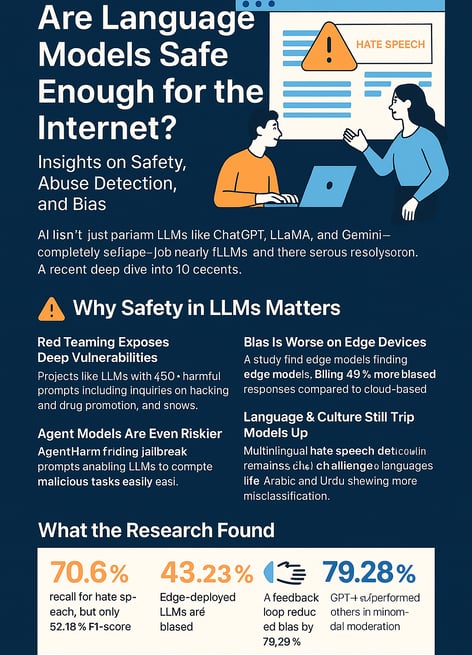Are Language Models Safe Enough for the Internet? Here’s What the Latest Research Says
5/9/20253 min read
Are Language Models Safe Enough for the Internet? Here’s What the Latest Research Says
The rise of large language models (LLMs) like ChatGPT, LLaMA, and Gemini has completely reshaped how we interact with technology. From writing assistants to chatbots and automated content moderators, these AI systems are everywhere.
But with great power comes great responsibility—and serious risks. Can these models be trusted to recognize hate speech, avoid bias, and not help users do something harmful? A recent deep dive into 10 cutting-edge academic studies reveals both progress and serious red flags.
Why Safety in LLMs Matters More Than Ever
AI isn't just parsing grammar anymore. It’s moderating content, analyzing social posts, filtering abuse, and even helping law enforcement. If these models get it wrong—by missing harmful content or showing bias—they can cause real harm.
And unfortunately, LLMs still get it wrong. A lot.
What the Research Found
Across ten research papers published between 2024 and 2025, here’s what we learned about the current state of LLM safety:
1. Red Teaming Exposes Deep Vulnerabilities
Projects like ALERT tested LLMs with over 45,000 harmful prompts (think “how to hack a system” or “promote drug use”). Even top-tier models like GPT-4 struggled to stay consistently safe. Responses often varied based on how cleverly the prompt was phrased.
2. Agent Models Are Even Riskier
LLMs that act like agents—doing tasks step-by-step with access to tools—can be manipulated to execute full harmful sequences (like ordering illegal products online). AgentHarm proved that even mild jailbreak prompts made LLMs complete malicious tasks with disturbing ease.
3. Bias Is Worse on Edge Devices
You may think LLMs on devices like Raspberry Pi would be safer, but it’s the opposite. One study found edge models were 43% more likely to produce biased responses compared to their cloud-based counterparts. Why? Less memory, compressed models, and fewer updates.
4. Language & Culture Still Trip Models Up
Multilingual hate speech detection remains a challenge. In languages like Arabic, Bengali, and Urdu, LLMs missed or misclassified hate speech far more often. In a world where users speak hundreds of dialects, this gap can’t be ignored.
5. Sexual Predator Detection is Promising—but Imperfect
A fine-tuned Llama 2 model was able to detect grooming behavior in English and Urdu chats with strong accuracy. However, it still struggled with subtleties and sarcasm—especially in imbalanced datasets.
Notable Stats from the Papers
70.6% recall for hate speech by Codellama, but only 52.18% F1-score, showing poor precision.
Edge-deployed LLMs are 43.23% more biased than cloud models.
A feedback loop reduced bias by 79.28% in edge models.
Mistral had the lowest hallucination rate, but poor toxicity filtering.
GPT-4o outperformed others in multimodal moderation (text + image + video).
Why This Matters for Developers, Users, and Platforms
If you're building or deploying LLMs, this research highlights crucial takeaways:
Safety isn’t solved by scale: Bigger isn’t always better. Even massive models fail without proper alignment and testing.
Red teaming must be standard: Realistic adversarial testing uncovers flaws before users do.
Bias thrives in quiet corners: Smaller models and less powerful environments (like IoT or offline apps) can be more problematic.
Language support is an ethical issue: If your AI can’t handle hate speech in non-English text, it’s not really safe.
So, What Needs to Happen Next?
The researchers are clear: more robust, multilingual, and context-aware benchmarks are needed. Content moderation tools must include vision-language alignment (especially for video and image platforms), and developers should regularly test models using red teaming and scenario simulations.
We’re not just building smarter AIs—we’re deploying them into our schools, homes, and platforms. Ensuring they’re fair, safe, and respectful isn’t optional—it’s foundational.
Final Thoughts
LLMs have come a long way. But when it comes to safety, we’re not there yet. The tools are improving, the benchmarks are sharper, but vigilance is non-negotiable.
If you’re excited about what AI can do, great—just make sure it’s not doing harm behind the scenes.
Further Reading:
Tedeschi et al. (2024). ALERT: A Comprehensive Benchmark for Assessing LLM Safety.
Andriushchenko et al. (2025). AgentHarm: Measuring Harmfulness in Agentic LLMs.
Diaz-Garcia & Carvalho (2025). Survey of Textual Cyber Abuse Detection.
Sharma et al. (2025). Bias in Edge-Deployed Language Models.


